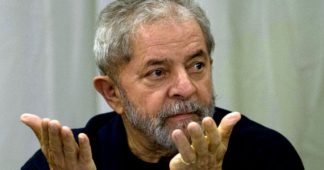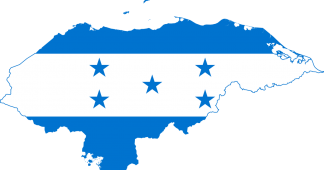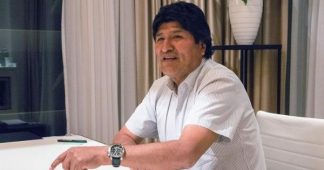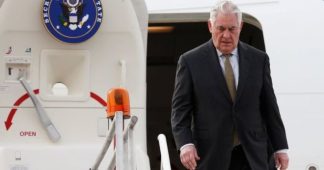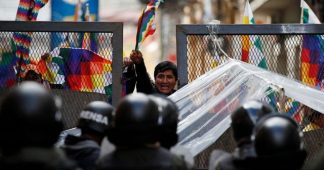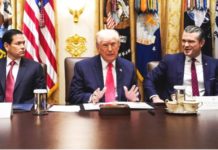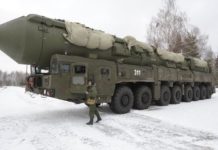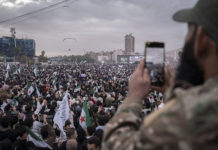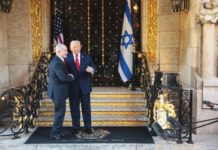Posted on
American interference with Latin American regimes began early and happened often. As early as the close of the nineteenth century, McKinley had betrayed and stolen Cuba. In 1903, Theodore Roosevelt severed Panama from Columbia, declared it an independent nation and put in power a government whose first act was to sign over the future Panama Canal. By 1908, America was already executing regime changes in Venezuela, cooperating in the removal of Venezuelan President Juan Vicente Gómez. A year later, President Taft took Nicaragua’s José Santos Zelaya out of power. McKinley, Roosevelt and Taft: the three presidents who steered America onto the path of regime change.
In these early days, the coups were usually won with the violence of the gun. That trend would continue in America’s backyard in the modern era. In 1954, Eisenhower ordered the overthrow of Guatemala’s Jacobo Arbenz. Eisenhower would also start the covert action to remove Fidel Castro from Cuba that Kennedy would continue. A decade later, in 1964, Kennedy would kick off the Brazilian coup that took out João Goulart and undertake the political action to encourage the removal of Cheddi Jagan from power in Guyana.
The trend of the fifties and sixties continued into the seventies, eighties and nineties. In 1971, Nixon would brutalize Chile with the coup against Salvador Allende; in 1989, George H.W. Bush would take out Panama’s Manuel Noriega. The last century would end and the next century would begin with Haiti’s Jean-Bertrand Aristide being twice removed. The twentieth century coups would continue with the short lived George W. Bush removal of Venezuela’s Hugo Chavez.
The Obama Administration
Then under Obama, coups changed. They went quiet. In the most cynical of moves, America, the champion of democracy, stopped using violence to undermine democracy and started using democracy to undermine democracy. Legitimately elected leaders began to fall, not to the bullet or bomb, but to coups in the disguise of democracy. The coup evolved into the silent coup: so silent, they were not heard nor noticed.
So disguised, these coups are taken for democracy. The coup is cloaked in one of two democratic disguises. In the first, the coup is mistaken for the legal and constitutional workings of a country’s parliament or congress. In the second, the minority that quietly lost in the private ballet box has its voice amplified as a mass democratic movement in the street. The streets of Venezuela and Brazil were packed with people whose voice, too small to be heard in the voting booth, was made to look loud when they poured out into the streets.
Honduras’ democratically elected president, Manuel Zelaya, Paraguay’s Frederico Franco and Brazil’s Lula da Silva and Dilma Rousseff were all democratically massaged from power. They did not fall to bullets and bombs: they fell to coups disguised as the constitutional and legal workings of government.
Zelaya was forced out of Honduras in a kidnapping disguised as a constitutional obligation. After Zelaya announced a plebiscite to determine whether Hondurans wanted to draft a new constitution, the hostile political establishment falsely translated his announcement into an unconstitutional intention to seek re-election. The ability to stand for a second term would be considered in the constitutional discussions, but was never announced as an intention by Zelaya. The Supreme Court declared the President’s plebiscite unconstitutional, the military kidnapped Zelaya, and the Supreme Court charged Zelaya with treason and declared a new president: a coup in constitutional disguise.
In Paraguay, Fernando Lugo fell to a parliamentary coup that first framed him and then gave him only twenty-four hours to prepare, and only two hours to deliver, a stillborn defense that was killed before it was delivered.
The new pattern of coups in the disguise of democracy continued in Brazil when President Dilma Rousseff was charged with “violating fiscal laws by using loans from public banks to cover budget shortfalls, which artificially enhanced the budget surplus:” a crime which the government’s federal prosecutor ruled was not a crime. That charge was the democratic disguise: Dilma was removed according to the obligations of the legal and constitutional working of a country’s government. But it was just a disguise. Dilma’s real crime was her refusal to implement a right-wing economic plan that featured cuts to health, education and welfare spending, as well as increased emphasis on privatization and deregulation and that was inconsistent with the economic platform on which Brazilians elected her. For that, she was removed in a coup, or, as coup leader Michel Temer euphemistically phrased it, “. . . the plan wasn’t adopted and a process was established which culminated with me being installed as president of the republic.”
The Trump Administration
But the evolution of the silent coup was not complete. The cynical use of democracy evolved one silent step further under the Trump administration. The Obama administration was the catalyst of the evolution of the coup into the silent coup, the coup so disguised as democracy that it is not recognized as a coup. In these coups, elected leaders were removed by methods that disguised the coup as the legitimate workings of democracy.
The Trump administration took the evolution one step further until the coup was even harder to see through the disguise of democracy. Where the Obama administration removed elected leaders, the Trump administration prevented them from getting elected. In the Trump years, legitimately elected leaders were removed by making the election appear illegitimate. The most recent evolution of the silent coup disguises the coup as democracy by disguising it as the defense of fair, democratic elections.
The first attempt appeared in Venezuela where Hugo Chavez’ successor, Nicolás Maduro, easily defeated his opponent, Henri Falcón, by a count of 6,245,862 to 1,927,387. But the elections outcome didn’t fit America’s script. So, Maduro had to be unelected. Under the new blueprint for the silent coup, Maduro’s election had to be choked by making it appear undemocratic. The democratic election had to be reversed by sleight of hand, by making a legitimate election appear illegitimate: a coup disguised as the defense of democracy.
The claim, the deception that the illusion depended on, was that the election was illegitimate because of a low voter turnout. But the turnout was low, not because of Maduro, but because of the radical opposition’s decision to boycott the election. Miguel Tinker Salas, Professor of Latin American History at Pomona College, and one of the world’s leading experts on Venezuelan history and politics, told me in a personal correspondence that the radical opposition boycotted the election “in order to claim that Maduro lacked legitimacy.” That was the plan. It was a coup in disguise. But the opposition’s decision was not an independent one. Jose Rodriguez, Venezuela’s communications minister, says that then U.S. Secretary of State Rex Tillerson called the opposition’s spokesperson, Julio Borges, and instructed him to refuse to sign the agreement.
And that’s not all. The real plan was to convince, not just the radical opposition, but the entire opposition to boycott, creating an uncontested election that could then be presented to the world as an illegitimate election. Latin America expert Mark Weisbrot has reported that “the leading opposition contender for Venezuela’s May presidential election, Henri Falcón, was told by US officials that the Trump administration would consider financial sanctions against him if he entered the presidential race.” When Falcón not only refused to boycott but reached out to other opposition leaders to side step the boycott and join his campaign, Todd Robinson, the top US diplomat in Venezuela, “met with Falcon” to try “to persuade him to withdraw as his challenge was undermining US efforts to isolate Maduro.”
Though the turnout was deliberately low, the election was still hardly uncontested. The opposition aligned pollster Datanalisis had Falcón in a statistical tie with Leopoldo Lopez, and significantly ahead of Henrique Capriles, as the most popular opposition candidate. Lopez and Capriles are often considered the two most popular opposition candidates.
The elections were not uncontested, and they were not illegitimate. At least four different groups of international observers monitored the election, including the International Electoral Accompaniment Mission of Latin America’s Council of Electoral Experts, an African Mission, and a mission made up of four Caribbean countries. All four certified the election as fair. The Council of Electoral Experts of Latin America (CEELA) is made up of former top electoral officials from throughout Latin America. It reported that “Technically, up until today, we have not observed any element that could disqualify the electoral process. . . . We can emphasize that these elections must be recognized, because they are the result of the will of the Venezuelan people.”
The second attempt succeeded. The new generation of silent coup brought down the popularly elected Bolivian government of Evo Morales by preventing his reelection As in Venezuela before it, the Bolivian coup was a manifestation of the evolved silent coup. The undesired winner was prevented from taking his office under the disguise of preserving the integrity of democratic elections. Again, the legitimate election had to undergo an American metamorphosis into an illegitimate election: the democratic process had to be respected and preserved.
The Bolivian constitution allows a president to be elected in the first round without a runoff if he or she wins at least 40% of the vote and defeats the person who came in second place by at least 10%. Morales won 47.1% of the vote, while the next closest candidate, Carlos Mesa, managed to win only 36.5% of the vote. So, Morales satisfied the criteria of a legitimate first round election.
Now for the coup disguised as democracy. The Bolivian opposition, supported by the hostile 60% US funded Organization of American States (OAS) declared that there were irregularities sufficient to reverse the election because of a pattern of reporting that showed a “drastic and hard-to-explain change” in the voting trend in Morales’ favor between the termination of the preliminary count and the reporting of the official count.
But the preliminary count is nonbinding and is only meant to track the results. It was intended to be halted when 80% of the vote was counted, so it was entirely appropriate to stop the preliminary tracking when it did: at 84%.
And, contrary to the OAS charge, the change in the trend was entirely expected and was neither hard to explain nor drastic. As the Center for Economic and Policy Research (CEPR) has demonstrated, and as Mark Weisbrot has clearly explained, the change was the result of geography and demographics, not cheating. Voting in Bolivia is all manual. So, rural districts take longer to report, and their results are included later. Morales dominates in the poorer and more indigenous rural areas. So, while opposition votes came in early, Morales’ votes came in later. Hence, the not-so-hard-to-explain change. Nor was the change “drastic.” Weisbrot reports that the “official data show a gradual change in the margin between the candidates as the mix of returns changed over time.”
And the CEPR was not alone in its findings. A new study by two specialists in election integrity, John Curiel and Jack R. Williams, both of MIT, has now arrived at, and reported, the same conclusion, revealing the defense of democracy to be a coup in disguise.
To avoid a runoff, Morales had to win by 40% and be ahead of his closest competitor by 10% at the end of the first round. Morales had 47.1%, so the contested question is whether he was really ahead by 10%. Curiel and Williams answer the question clearly: “Our results were straightforward. There does not seem to be a statistically significant difference in the margin before and after the halt of the preliminary vote. Instead, it is highly likely that Morales surpassed the 10-percentage-point margin in the first round.”
Curiel and Williams add the statistical support that “We didn’t find any evidence of any of these anomalies. . .. We find a 0.946 correlation between Morales’s margin between results before and after the cutoff in precincts counted before and after the cutoff. There is little observable difference between precincts in the results before and after the count halt, suggesting that there weren’t any significant irregularities.” Their simulations predict a 10.49 point lead: more than the necessary 10 points.
Curiel and Williams conclude that “There is not any statistical evidence of fraud that we can find – the trends in the preliminary count, the lack of any big jump in support for Morales after the halt, and the size of Morales’s margin all appear legitimate. All in all, the OAS’s statistical analysis and conclusions would appear deeply flawed.”
The MIT researchers also cast a shadow over the OAS’s sincerity: “The OAS’s report has basic methodological and statistical errors that make it difficult to see the OAS as an impartial election observer.”
Both Maduro and Morales had to go, and both had their legitimate elections photoshopped into stolen elections, revealing the next step in the evolution of American coups. The first coups rained “the terrors of the earth” and changed regimes with an ungentle hand. As the planes and loud bombs of war gave way to silent drones in the Obama years, so coups by bombs and bullets were replaced by the silent coups disguised as democracy. Legitimate and popular leaders were removed under the guise of the popular and legitimate workings of democracy. Actions in Venezuela and Bolivia have discovered the next stage in the evolution of the American coup. The silent coup has evolved in the Trump era into an even quieter coup that prevents a leader from taking office and is even harder to spot and to recognize underneath its disguise of democracy, a coup in which undesirable leaders who are legitimately elected are removed by making the election appear illegitimate. And so, democracy is cynically strangled in a coup that is seen by the world as the defense of democracy.
* Ted Snider writes on analyzing patterns in US foreign policy and history.
Published at https://original.antiwar.com/ted_snider/2020/03/09/quieter-and-quieter-the-evolution-of-latin-americas-silent-coups/
